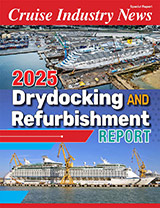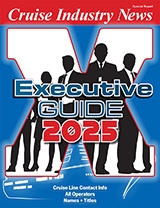Royal Caribbean Cruises has reported net income of $122.4 million, or $0.57 per share, on revenues of $1.3 billion for the second quarter ended June 30, 2006, compared to net income of $155.2 million, or $0.72 per share, on revenues of $1.2 billion for the second quarter of last year. While net earnings were down, RCC still beat analysts’ estimate of $0.53.
But the combination of lower earnings, escalating fuel costs, softer Caribbean and Bermuda markets and a booking window that is moving closer in, the market responded by dropping the shares some 4 percent to below $35 immediately following the Q2 earnings call, compared to a 52-week low/high of $34.25 to $47.95.The average 12-month price target is $48.57.
RCC’s earnings guidance is from $2.90 to $3.00 for the year, compared to $3.26 for 2005. The Street consensus is $2.93 for 2006 and $3.26 for 2007.
Impacting Q2
RCC said that while net yields were up 6 percent over Q2 05, which it attributed to strong pricing and higher onboard revenue, net cruise costs increased by 14.4 percent, driven by higher fuel prices, as well as other expenses, including the revitalization of the Century, inaugural expenses for the Freedom of the Seas, other marketing expenses, and other items such as expensing of stock options, legal fees and additional operating costs in Cozumel due to hurricane damage, as well as what it called inflationary pressures.
Other contributing factors were lower than expected depreciation and amortization expenses, less interest expenses due to lower rates, and more interest income due to higher cash balances.
According to Chairman and CEO Richard Fain, Royal Caribbean International and Celebrity Cruises are doing very well m Europe and Alaska, while the Caribbean and Bermuda markets are seeing some softness, although Fain said he expects Caribbean yield to be up year-over-year.
Fuel continues to be a significant and growing component of the cost structure. Fain said, noting that efforts to reduce fuel consumption included itinerary tweaking, silicone hull paints, window treatments and the installation of diesel engines on the ships that only have gas turbines.
The company has also started to use limited quantities of bio-diesel fuel on its gas turbine ships, which Fain said bums even cleaner than marine gas oil.
Q3 and Q4
Royal Caribbean’s guidance for Q3 is in the range of $1.52 to $1.57 per share, compared to $1.64 in 2005.
Q4 is expected to be particularly strong, according to Royal Caribbean, which attributed its expectations to revenue increases and the allocation of expenses, with fewer expenses falling in this year’s fourth quarter, compared to last year’s.
Based on the earnings’ guidance for the year, Q4 earnings ould be in the range from $0.21 to $0.36, pending Q3 results and whether Royal Caribbean ends up at the low or high end of its forecast. Full year earnings forecasts have been adjusted downward from $2.95 to $3.15 in April to $2.91 to $3.11 in May, according to Louis Leon, CFO.
2007
The outlook for 2007 is positive, according to Fain, who said that bookings so far are consistent with “where we were the same time last year.” He cited the introduction of the second Freedom-class ship, the Liberty of the Seas, and the full-year service of the Freedom and the Century.
However, escalating fuel costs and bookings moving back closer in limit future visibility.
For 2007, the two brands will also have more capacity in Europe. Royal Caribbean International; will have six ships and 14,000 berths in Europe, according to brand President Adam Goldstein, who added that a large component of the guests is being sourced in Europe. “On some ships, the guest mix is nearly equal – Europeans and Americans,” he added.
Goldstein would not reveal the percentage mix of North American and European passengers, however, but only said that “this is the directionality of the trend.”
Goldstein noted that by extending the European season. Royal Caribbean is also reducing some of its Caribbean capacity during the typically softer fall. “This is the direction we are going,” he pointed out.
The two brands will have 16 percent of their combined capacity in Europe in 2007, compared to 14 percent this year.
At Celebrity, President Dan Hanrahan said that the brand continues what he called its strong yield performance, which he said he expects to continue during the second half of the year.
Comments
In Royal Caribbean’s Q2 earnings call, Goldstein said that the obvious highlight of the quarter was the introduction of the Freedom.
“The reality of the ship backed up the hype,” he said, with the ship offering very high guest satisfaction and revenue generation.
Celebrity will have a good Q4, according to Hanrahan, who attributed that to staying in Europe longer, as well as the Century’s four- and five-day cruises. Offered for the first time in Q4, Hanrahan said, the short cruises are “meeting with great response from incentive houses.”
Hanrahan also noted that Celebrity is not seeing any impact on next year’s bookings from higher air costs. Part of that potential issue is being mitigated, however, by sourcing passengers in Europe, for example, and by deploying ships from more homeports, he added. The conflict in the Middle-East has had no impact on Mediterranean cruises, Hanrahan said.
Cruise line executives would not pinpoint the reasons for the softness in the Caribbean, but said only that “several different factors are likely behind the pricing pressure” in the region. Still, Royal Caribbean expects the overall yield outlook to be positive, according to Goldstein.
He also noted that while September has traditionally been a challenging month, August is now also becoming more of a challenge.
As for a fuel surcharge, Fain said that the company will watch the market and that a surcharge is a temporary effort which is not in the direction he wants to go.
Six Months
For the six month period. Royal Caribbean reported net income of $241.9 million, or $1.2 per share, on revenues of just above $2.4 billion this year, compared to net income of $344.8 million, or $1.36 per share, on revenues just below $2.4 billion last year.
The two brands reported 11.3 million passenger cruise days this year, compared to 11.4 million last year.
Onboard and other revenues were $644.4 million this year, compared to $611 million last year. Fuel costs jumped from $158.4 million in 2005 to $234.2 million this year – a 75.8 percent increase, although the comparison may not be fully accurate with more of last year’s fuel costs being hedged.
Estimated food spending per day was $7.90 for the first six months of 2006, compared to $7.93 last year (combined for passengers and crew).
Noted
The tone of the Q2 conference call was more muted, with analysts being notably less congratulatory than in the past. And one could almost sense an ice wall being brought up when the question was raised (David Liebowitz, Burnham Securities) whether Celebrity has reached the break-even point or not. Company executives would not comment.



